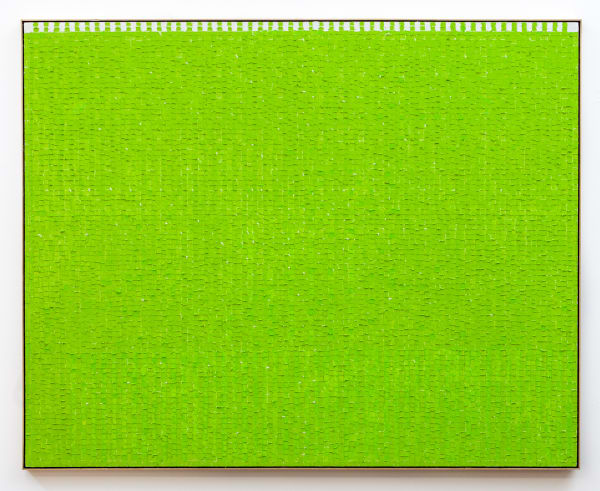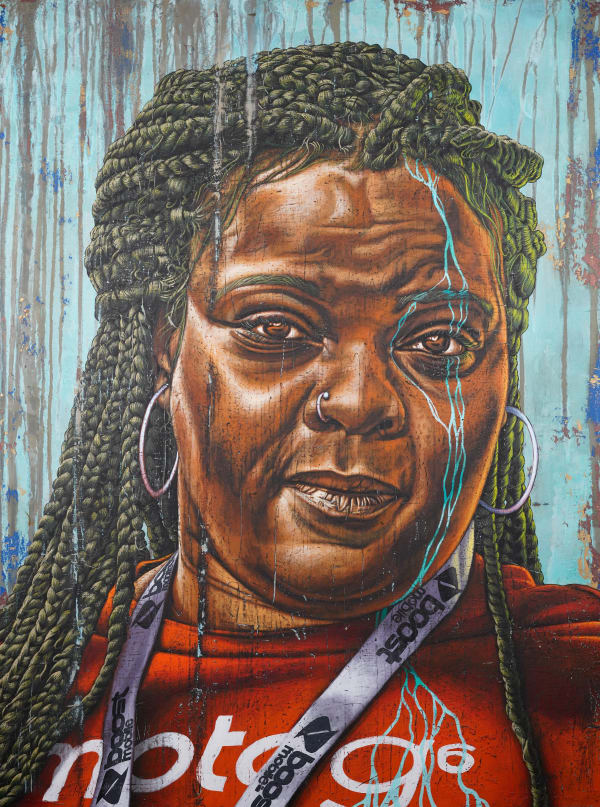-
Frieze London Online 2020
Kavi Gupta is proud to be part of Frieze London’s 2020 online viewing room. Innovative platforms like this offer us ways to stay connected with our global community of collectors, curators and researchers, and to continue celebrating the important art and artists that are shaping our collective future.
Our 2020 Frieze London Viewing Room highlights works by a diverse roster of international artists who are exploring the evolving relationships between painting, sculpture, history and politics; perceived boundaries between objective and non-objective art; and the power of context to transform the relationship between viewers and aesthetic phenomena.
This presentation places artists from around the world in a common dialogue, illustrating their diverse perspectives and equally diverse techniques and strategies. Works by Young-Il Ahn, Roger Brown, Alfred Conteh, Beverly Fishman, Jeffrey Gibson, Richard Hunt, Deborah Kass, Manish Nai, Tony Tasset, and Kennedy Yanko will be featured.
Free registration for the Frieze London Viewing Room will open soon.
-
-
Beverly Fishman’s highly-polished Pill Reliefs utilize iconic pharmaceutical forms as the basis for seemingly abstract compositions that radiate with color. Made with urethane automotive paint and medium-density fiberboard (MDF), the works sometimes reference a single pill form and other times present an assemblage of pill forms — a chemical cocktail.
Integral to the success of these works is the fact that so many of them possess distinctive voids. Nicknamed “Missing Doses,” these pieces engage vacant space with color and light.
-
-
-
SHE KNOWS OTHER WORLDS, 2019 debuted in CAN YOU FEEL IT, Gibson's first solo exhibition at Kavi Gupta. Inspired by four years in the mid-1990s when Gibson called Chicago home, the exhibition’s title echoes the classic house jam of the same name by Chicago-born DJ Larry Fine, a.k.a. Mr. Fingers. Says Gibson, “This was a period when house music was so welcoming and inclusive, and being in Chicago was very optimistic. There was a space carved out for people of different backgrounds coming together and celebrating each other, letting everything go and having a good time. It felt hopeful. That was a big critical experience for me in terms of thinking about how to respond to a challenging larger culture.”
Come to My Window, 2020 takes its name from the 1993 Melissa Etheridge hit, Come To My Window. Gibson's artistic practice is frequently informed by music. Many of his recent works reflect upon a time in the mid-1990s when Gibson called Chicago home. Says Gibson, “This was a period when house music was so welcoming and inclusive, and being in Chicago was very optimistic. There was a space carved out for people of different backgrounds coming together and celebrating each other, letting everything go and having a good time. It felt hopeful. That was a big critical experience for me in terms of thinking about how to respond to a challenging larger culture.”
-
Mining the history of art and pop culture, Deborah Kass creates works that parody and critique standard narratives of postwar art. After Louise Bourgeois, 2010, plays off the spiraling neon light sculptures of Bruce Nauman. Catching our attention with a spectrum of colors, we must work to decipher its message, an altered quotation by Louise Bourgeois with a decidedly feminist message: “A woman has no place in the art world unless she proves over and over again that she won’t be eliminated.”
-
-
For more than 30 years, Ahn has been attempting to capture the illusive, shimmering color and light of water in his paintings. In 2017, the Los Angeles County Museum of Art (LACMA) acquired part of this series and then presented Unexpected Light: Works by Young Il Ahn, the first solo exhibition of a Korean American artist at LACMA. Curated by Virginia Moon, LACMA's assistant curator of Korean art, the exhibition featured 10 large oil paintings from Ahn's Water Series. Moon wrote at the time, "The Water series (1983–ongoing) takes inspiration from [Ahn's] experience of being lost on the Pacific Ocean off the coast of Santa Monica. In 1983, Ahn was aboard a small fishing boat when he was caught in a fog so dense that he could not see his hands in front of his face; suddenly, the fog cleared, revealing sunlight on the water all around him. This vision and experience would shape his practice for decades to come."
-
Roger Brown (b.1941—d.1997) is renowned for using a pop aesthetic to investigate a range of socio-political issues. His trademark silhouettes and curvilinear landscapes depict both the topical and uncomfortable.
Brown’s work is of startling contemporary relevance, cleverly approaching many topics from the natural and built environment, disaster, religion, the art world, popular culture, art history, eroticism, and socio-political concerns from modern warfare to mortality during the HIV/AIDS crisis. Rich in content and innovative in methods of depiction, Brown presaged the subjective and surreal figuration seen in many threads of recent painting. During his lifetime, art dealer Phyllis Kind was Brown’s exclusive representative, and she was the first to exhibit his work in 1971.
Brown’s career abounded with solo and group shows internationally, and notable retrospectives of his work were shown by the Montgomery Museum of Fine Arts in 1980, and at the Hirshhorn Museum in 1987. The Roger Brown Study Collection, maintained by the School of the Art Institute of Chicago with curator Lisa Stone, makes Brown’s prolific art collection and archive available to the public.Brown’s political paintings were recently featured at DC Moore Gallery, New York and his Virtual Still Life works were highlighted in a solo exhibition at Maccarone, New York. Brown received his BFA and his MFA at the School of the Art Institute of Chicago.
-
In Alfred Conteh's latest series “Two Fronts,” Conteh paints the people that he meets where he lives and works in Atlanta. He presents his subjects as they really are, yet allegory is embedded heavily within the materiality of his work. His materials include battery acid, rust and metal dust, giving the surfaces of his paintings a quality similar to that of the decaying, neglected buildings that dot the landscape of the neighborhoods captured in his paintings. This is not just an aesthetic choice, but a call for viewers to confront the reality of the world we all live in.
Says Conteh, "The way I look at my work is they're not just paintings, they're reminders. They should be reminders to everyone who looks at them, that this is the reality of Black folks in this country right now. Specifically the Black folks whose shared experience is as the descendants of slaves. You should be reminded. Me, you, and everybody who lives here as Americans. There is a group of people who are American in name, but who are not American in practice. If you have this painting on your wall, what you should say to yourself is is there are people living like this. This is their reality every day. What should I do to make these folks American just like me? If you’re white, ask what should I do to make these folks who built this country American just like me so they have the same rights, privileges and protections, just like me. When it comes to the bleakness, I want people to see themselves in this work. See that poverty, see those stresses, see the disrepair. If we're going to talk about equality in this country, let it start with me."
-
-


















